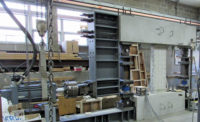Susceptibility to extreme seismic forces need not be a barrier to the use of accelerated bridge construction methods, according to researchers at the University of Nevada, Reno’s Earthquake Engineering Laboratory. On March 24, the lab’s hydraulically driven shake tables subjected a 70-ton, two-span, 70-ft-long bridge to multiple 7.5-magnitude simulations of the 1994 Northridge, Calif., earthquake. The structure incorporated six different types of bridge connections already individually tested for seismic performance. Four were designed to survive undamaged, with two others configured to absorb a specific level of force before breaking. All connections performed as expected, according to principal investigator Saiid Saiidi, director of the university’s Center for Advanced Technology in Bridges and Infrastructure.
Bridge Connections Perform Well in Lab Shake Table Tests

Susceptibility to extreme seismic forces need not be a barrier to the use of accelerated bridge construction methods, according to researchers at the University of Nevada, Reno’s Earthquake Engineering Laboratory.
PHOTO COURTESY OF UNIVERSITY OF NEVADA, RENO



